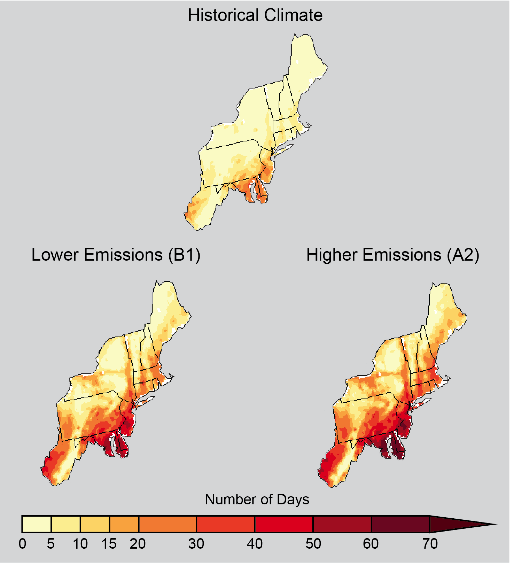The Northeast region of the United States is home to a tremendous array of edible crop production including all except sub-tropical species.
The region has a wide variety of climate zones, soil types, and accessible, large markets, and has a long history of terminal markets that connect our product to international buyers. Northeast farmers also tend to be early adopters in terms of new crops and new production techniques. The fact that our farms tend to be smaller allows the industry as a whole to be responsive to change. These attributes help compensate for regional challenges which include high land values, diminishing access to prime farm land, urban-farm conflicts, invasive pests, and, an extremely variable climate. Climate vagaries that impact specialty crop production include too much or too little precipitation, unpredictable winter and spring temperatures, extreme summer heat, and wind. Between 1895 and 2011, temperatures in the Northeast increased by almost 2˚F (0.16˚F per decade), and precipitation increased by approximately five inches, or more than 10% (0.4 inches per decade). As Figure 1 indicates, the impact of warming will be widespread. Extreme heat impacts ripening, pest pressure, and water demands. It can also exacerbate fruit and foliar damage to plants, including sun scald. Researchers and growers are working together on solutions, such as high tunnels, to shelter crops from the effects of climate change. More information about low and high tunnel production of berry crops can also be found here.
 Heavy rain events cause erosion on sloped ground and intensively cultivated plasticulture production – a norm for annual vegetable production in the Northeast. Single day heavy rain events tracked from 1958- 2012 have increased 71% in the Northeast. (Figure 2). Perennial crops such as tree fruit, berries and grapes are impacted most severely by unpredictable winters. The lengthening autumn season is a boon for those farmers that are growing longer season cultivars of apples, but some cultivars may be getting all their required chilling hours in the fall – a great thing if they then go into a deep dormancy. If the winter is warm, then the plants will respond to lengthening days and aberrant warmth in late winter, only to be severely injured when early spring temperatures return to ‘normal’. This fluctuation sets perennial fruit crops up for losses to winter injury and frost damage in the spring. The net loss of fruit value in tree fruit and berries due to the 2012 NE spring freeze was $71M. To help growers assess spring frost risk, the Cornell Institute for Climate Smart Solutions has developed an Apple Freeze Risk decision tool and a Grape Hardiness and Freeze Risk decision tool.
Heavy rain events cause erosion on sloped ground and intensively cultivated plasticulture production – a norm for annual vegetable production in the Northeast. Single day heavy rain events tracked from 1958- 2012 have increased 71% in the Northeast. (Figure 2). Perennial crops such as tree fruit, berries and grapes are impacted most severely by unpredictable winters. The lengthening autumn season is a boon for those farmers that are growing longer season cultivars of apples, but some cultivars may be getting all their required chilling hours in the fall – a great thing if they then go into a deep dormancy. If the winter is warm, then the plants will respond to lengthening days and aberrant warmth in late winter, only to be severely injured when early spring temperatures return to ‘normal’. This fluctuation sets perennial fruit crops up for losses to winter injury and frost damage in the spring. The net loss of fruit value in tree fruit and berries due to the 2012 NE spring freeze was $71M. To help growers assess spring frost risk, the Cornell Institute for Climate Smart Solutions has developed an Apple Freeze Risk decision tool and a Grape Hardiness and Freeze Risk decision tool.
Figure 1 (top, left). Projected number of days per year with a maximum temperature greater than 90°F averaged between 2041 and 2070, compared to 1971-2000 (Historical Climate), assuming continued increases in global emissions (A2) and substantial reductions in future emissions (B1). Source: NOAA NCDC / CICS-NC.
Figure 2 (bottom, left) Change from 1958-2012 of single day heavy precipitation events across the United States. Source: NOAA/NCDC
Photo 1 (above, right) Erosion in plasticulture strawberries in Schoharie county NY, late spring 2017. Photo by L. McDermott

Laura McDermott, a regional extension specialist in small fruit production for the Eastern New York Commercial Horticulture Program, currently serves 17 counties in the Route 87 corridor, where she concentrates on small fruit production and fresh market vegetable production. Her current research projects include low-tunnel strawberry production, soil-borne pests of strawberries, resistance management education, and invasive species management, including spotted wing drosophila. Email | Phone: (518) 746-2562.
Kunkel, K. E., L. E. Stevens, S. E. Stevens, L. Sun, E. Janssen, D. Wuebbles, J. Rennells, A. DeGaetano, and J. G. Dobson, 2013: Regional Climate Trends and Scenarios for the U.S. National Climate Assessment: Part 1. Climate of the Northeast U.S. NOAA Technical Report NESDIS 142-1. 87 pp., National Oceanic and Atmospheric Administration, National Environmental Satellite, Data, and Information Service, Washington, D.C.

